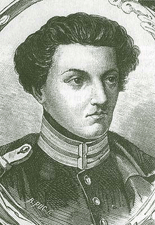Jan Paweł Lelewel
- View a machine-translated version of the Polish article.
- Machine translation, like DeepL or Google Translate, is a useful starting point for translations, but translators must revise errors as necessary and confirm that the translation is accurate, rather than simply copy-pasting machine-translated text into the English Wikipedia.
- Do not translate text that appears unreliable or low-quality. If possible, verify the text with references provided in the foreign-language article.
- You must provide copyright attribution in the edit summary accompanying your translation by providing an interlanguage link to the source of your translation. A model attribution edit summary is
Content in this edit is translated from the existing Polish Wikipedia article at [[:pl:Jan Paweł Lelewel]]; see its history for attribution. - You may also add the template
{{Translated|pl|Jan Paweł Lelewel}}to the talk page. - For more guidance, see Wikipedia:Translation.

Jan Paweł Lelewel (26 June 1796 in Warsaw – 9 April 1847 in Bern) was a Polish military and civil engineer, builder, and painter.
He was the brother of Joachim Lelewel, Polish historian and politician, and of Adam Prot Lelewel. They were all sons of Karol Maurycy Lelewel, secretary treasurer of the Commission of National Education and of Ewa Szeluta-Małynicka (1763-1837). His paternal grandfather had been the court doctor of August III, Henryk Loelhoeffel von Lowensprung.
From 1809, he attended the School for Cadets in Warsaw, after which he took part as a sergeant major in the 1812 invasion of Russia. In 1815, he became an officer in the Engineer Corp of the army of The Duchy of Warsaw. In 1823, he was responsible for the rebuilding works at Zamość Fortress. Subsequently, he took part in the building of Augustow Canal. He was given the Order of St. Vladimir, Fourth Class.
He took part in Polish November Uprising, in which he was in charge of maintaining fortifications in Praga, then a suburb of Warsaw. He began his military duty as a captain and ended it as a lieutenant colonel. After the defeat of the insurrection, he left the country for France.
Bibliography
- A. Czolowskic: Zapomniany fortyfikator Zamościa. Teka zamoj. R. l (5): 1938 nr 3 s. 153 nn. Inż. Jan Paweł Lelewel;
- Jacek Feduszka: Jan Paweł Lelewel (1796-1847), in: Zamojski Kwartalnik Kulturalny nr 3-4/1999 s.77-84 2000;
- Lelewel, Prot und Joachim Lelewel: Żywot Jana Pawla Lelewela, podpułkownika i inżyniera, Posen 1857;
- Orłowski, Bolesław (red.): Słownik polskich pionierów techniki, Katowice 1984, s. 118-119;
- Polski Słownik Biograficzny, Band XVII, S. 19;
- Przegon, Wojciech: Jan Paweł Lelewels Generalplan zum Projekt der Trockenlegung der Sumpfgebiete des Seelandes (1834). Vermessung Photogrammetrie Kulturtechnik. Schweiz, 8, 1999, S. 432-434;
- Przegon, Wojciech: Krajobrazy XIX-wiecznego Zamościa w akwarelach i rysunkach Jana Pawła Lelewela. Krakau 1997;
- Przegon, Wojciech: Jan Paweł Lelewel - inżynier wojskowy. Biuletyn Regionalny Zakladu Doradztwa Rolniczego Akademii Rolniczej w Krakowie 2001;
- Zieliński, Jan: Nasza Szwajcaria. Przewodnik śladami Polaków, Warszawa 1999, s. 24-25, 141;
- v
- t
- e
 | This article about a Polish painter is a stub. You can help Wikipedia by expanding it. |
- v
- t
- e











